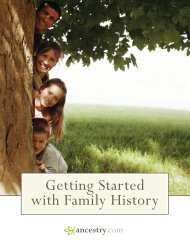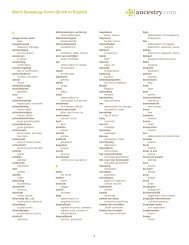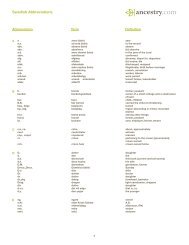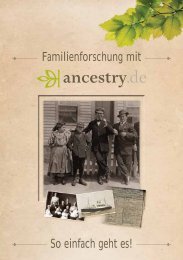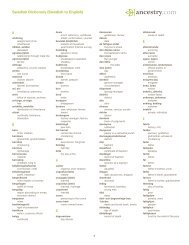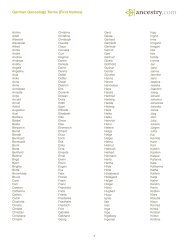Tracing Your Paternal Ancestry
Tracing Your Paternal Ancestry
Tracing Your Paternal Ancestry
You also want an ePaper? Increase the reach of your titles
YUMPU automatically turns print PDFs into web optimized ePapers that Google loves.
FACTSHEET 2<br />
<strong>Tracing</strong> <strong>Your</strong> <strong>Paternal</strong> <strong>Ancestry</strong><br />
What is it all about?<br />
Introduction<br />
The Y chromosome is passed down from father to son and this inheritance continues back up through the<br />
paternal line. As a result only males may take the Y-chromosome test.<br />
Mutations can however occur within the Y-chromosome meaning that a son's<br />
results may vary slightly from their father’s or brother's for example.<br />
Females interested in tracing their paternal lineage will therefore need to find a<br />
willing male relative, such as a father, brother or cousin to take the test.<br />
How does the Y-Chromosome test work?<br />
The Y-Chromosome test focuses on specific regions of the Y-chromosome and looks for series of repeating sequences<br />
of DNA molecules called “Short Tandem Repeats” (STRs). These repeats are found in differing numbers<br />
amongst the male population and it’s the variations in the number of times these repeats occur which determine<br />
the results of the Y-DNA test.<br />
<strong>Ancestry</strong> offers two Y-chromosome test options based on the number of markers being tested against. The more<br />
markers tested, the more accurate an estimate of the relationship between two individuals can be made.<br />
The Y-chromosome test will also provide a look into your ancient paternal ancestry through a prediction of your<br />
ancient haplogroup. Haplogroups (or deep ancestral groupings) were formed when ancient peoples migrated and<br />
branched out from Africa over 100,000 years ago. As they spread throughout the world and adapted to their new<br />
environments their DNA diversified, creating new resultant groups and subgroups.<br />
What will I discover?<br />
<strong>Your</strong> <strong>Paternal</strong> Lineage test result consists of two components: Y-DNA results and a paternal ancient ancestry<br />
prediction.<br />
Y-DNA Results<br />
<strong>Your</strong> results will consist of a table of markers tested (1-33 or 1-46) together with a corresponding value (or<br />
“allele”) for each. Each marker is a specific location on the Y-chromosome and is referred to by its DNA Y-<br />
chromosome Segment or DYS number. The portions of the Y-chromosome tested are known to produce repeating<br />
patterns of nucleotides (the building blocks of DNA).<br />
These Short Tandem Repeats (STRs) are counted at each marker and reported as your DNA result. The profile of<br />
repeats is inherited from your father and is what differentiates your specific paternal lineage from another's. The<br />
extent to which your Y-DNA results match other participants will determine how closely related you might be by<br />
providing an estimate of how far in the past you shared a common ancestor.<br />
Page 1 of 4
FACTSHEET 2<br />
Each of Y-chromosome locations available for testing are presented in the table. A dash, "-", means that results<br />
were not produced for that particular location because of two possible factors. Firstly, for markers DYS19b,<br />
DYS464e and DYS464f, a lack of result may be due to the fact that these allele results are very rare. Secondly, the<br />
dash may signify the presence of a marker value that cannot be obtained using the current testing methodology.<br />
<strong>Paternal</strong> Ancient <strong>Ancestry</strong><br />
<strong>Your</strong> <strong>Paternal</strong> Ancient <strong>Ancestry</strong> (or Haplogroup) is predicted based on your Y-DNA results. You will receive the<br />
name of the haplogroup, a detailed description of the group, and a map showing how your ancient ancestors migrated<br />
out of Africa over 100,000 years ago and split off to populate the different regions of the world.<br />
What do I do after I receive my Test Results?<br />
Once you have your results, you’ll be able to compare them with other participants on the DNA <strong>Ancestry</strong> Database,<br />
through a number of different on-site tools.<br />
1. Matching Map<br />
The Matching Map will show the approximate current location throughout the world of the most closely matching<br />
participants. Clicking on a figure in the map will display the name (if not anonymous), location, and an estimate of<br />
Most Recent Common Ancestor (MRCA). The list of participant names is sorted by MRCA, with those most<br />
closely related to you at the top of the list. You can directly compare your DNA results with other closely matching<br />
participants by clicking the checkbox by their names and pressing the "Compare" button.<br />
Page 2 of 4
F ACTSHEET 2<br />
2. Comparison Table<br />
The table displays your selected participants' results in relation to how similar or different they are from your results.<br />
When your markers and repeat values match, you will see a checkmark. Where your markers differ, you will<br />
see the value highlighted. The greater the number of differences, the more distantly related you are.<br />
3. Common Ancestor<br />
If you have found a closely matching participant, you can further analyse how related you might be by clicking on<br />
the Participant's name. The Most Recent Common Ancestor (MRCA) calculation is based on the number of markers<br />
tested and the number of matching values. The MRCA reports the range of generations in which you and another<br />
participant may have shared a common ancestor. The closer the match, the more narrow the range of<br />
generations will be.<br />
A second calculation is made to determine the Most Likely Estimate (MLE) to help pinpoint the most likely generation<br />
where a common ancestor might be shared. Together, you can obtain both the range of generations and the<br />
most likely generation within that range to help pinpoint your common ancestor.<br />
Page 3 of 4
FACTSHEET 2<br />
3. Common Ancestor<br />
If you have found a closely matching participant, you can further analyse how related you might be by clicking on<br />
the Participant's name. The Most Recent Common Ancestor (MRCA) calculation is based on the number of markers<br />
tested and the number of matching values. The MRCA reports the range of generations in which you and another<br />
participant may have shared a common ancestor. The closer the match, the more narrow the range of generations<br />
will be.<br />
A second calculation is made to determine the Most Likely Estimate (MLE) to help pinpoint the most likely generation<br />
where a common ancestor might be shared. Together, you can obtain both the range of generations and the<br />
most likely generation within that range to help pinpoint your common ancestor.<br />
4. Comparing Pedigrees<br />
Armed with a range of generations in which you might share a common ancestor, you can then begin communicating<br />
with your genetic cousins using the <strong>Ancestry</strong> Connection Service as the first step towards comparing the genealogies<br />
of your two families. If you're fortunate, the common ancestor analysis will narrow your search to a timeframe<br />
and you will find the ancestor that joins your two family trees.<br />
Next Steps<br />
Firstly, thank you again for taking the time to read this factsheet. If you are now ready to take one of tests, simply<br />
continue through to the ordering page on the <strong>Ancestry</strong> website. If not, then we hope you’ve found this factsheet<br />
informative in helping you decide whether this test would be appropriate for you in the future as you further progress<br />
your family history research. If you’ve not done so already, you can also read or other factsheets on DNA<br />
testing and tracing your maternal ancestors.<br />
Page 4 of 4



